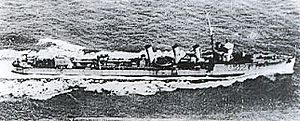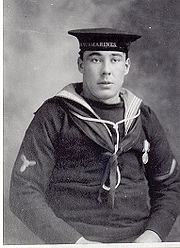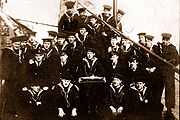
HMS G9
Encyclopedia
HMS G9 was a British G class submarine
, one of eight Royal Navy
submarines lost to friendly fire
in World War I
.
at Barrow-in-Furness
, G9 was laid down on 8 December 1914. She was launched on 15 June 1916, and commissioned on 22 August that year.
and German Bight
in search of U-boats.
after mistaking Pasley for a U-boat in foul weather on the night of 16 September 1917 and firing two torpedoes at her. The first struck Pasley on her starboard quarter, but too acutely to detonate; the second passed astern. On seeing the submarine’s wash Pasleys officer of the watch, Midshipman
Frank Wallis, RNR, put his boat hard to starboard and rammed G9 just aft of amidships all but cutting her in two, and she sank less than one minute later with the loss of all but one of her crew, Stoker William Drake.


 Commanded by Lieutenant Commander
Commanded by Lieutenant Commander
The Hon. Byron Plantagenet Cary, Bt.,, G9 had sailed Scapa Flow
on 9 September to patrol an area between Shetland and Norway
. On 15 September, she was ordered north to between latitudes 60.30 N and 61.30 N to keep her clear of the fleet on exercises en route from Rosyth
to Scapa. Meanwhile, Pasley was attempting to locate merchantmen detached from the convoy she was escorting in appalling weather from Aspö Fjord in Norway
to Lerwick
, and had resorted to displaying a white light halfway up the mast by night. Weathering the heavy seas and blinding rain squalls, Cary sighted Pasley’s light. Forewarned a U-boat
was in the area, he gave the order to attack. Presumably realizing the error soon afterwards, Cary ordered the connection of the cruiser arc lamp to signal the destroyer. The signal was recognized aboard Pasley; her captain
, Commander
Charles Ramsey
, ordered 'Full Astern', but it was too late to prevent his ship ramming the submarine.
After the collision, the crew on G9 were ordered to assemble beneath the conning tower
. Stoker William Drake saw one man climb the ladder above him, and followed. Although caught in the stomach by the lower conning tower door, which had probably been ordered shut in the hope of keeping the boat buoyant, Drake managed to struggle free and reach the bridge, only to be swept off as the boat sank beneath him. Of the five men in the water, Drake was the only one to reach Pasley, which had stopped to rescue survivors. Weakened by the effort and numbed by the cold water, Drake was unable to pull himself up on the lifeline lowered, and was only rescued after Able Seaman Henry Old clambered over the side of the destroyer to secure a running bowline
around him; he was then hauled aboard and taken below. Still unconvinced of his attacker's identity, Commander Ramsey went to question the survivor. Finding Drake laid on his stomach to help rid his lungs of seawater, Ramsey kicked the soles of his feet and demanded to know his nationality.
at Scapa, it was decided no blame could be attached to Pasley, concluding "that the process of reasoning which led the captain of HM Submarine G9 to mistake HMS Pasley for a U-boat is, and must remain, unexplained".
The findings were forwarded to the Commander in Chief, Grand Fleet, Admiral
David Beatty
, who remarked that the incident was "...one of those that are inseparable from war", but deplored the delay in introducing improved signalling facilities on submarines, particularly the substitution of the slow, unreliable and cumbersome cruiser arc lamp with Aldis lamps.
Their Lords Commissioners of the Admiralty later directed Commander Ramsey to inform Midshipman Wallis that in the opinion of the Court of Inquiry the action taken by him "was the right action to take under the circumstances, and that its result, so deeply to be regretted, is evidence that it was taken with commendable promptness and precision....".
HMS Swale
as Stoker Petty Officer
in World War II
; he died in 1974 aged 80. Commander Charles Gordon Ramsey rose to the rank of Admiral
, was knighted, and served as aide-de-camp
to King George VI; he died in 1966 aged 84. Ramsey's portrait, by Bassano, hangs in the National Portrait Gallery, London.
British G class submarine
The Royal Navy's G-class of diesel/electric submarines were launched between 1914 and 1917, and intended for operations in the North Sea and German Bight in World War I against German U-boats. The design was based on the E-class, adopting the double hull concept, but in practice showed little...
, one of eight Royal Navy
Royal Navy
The Royal Navy is the naval warfare service branch of the British Armed Forces. Founded in the 16th century, it is the oldest service branch and is known as the Senior Service...
submarines lost to friendly fire
Friendly fire
Friendly fire is inadvertent firing towards one's own or otherwise friendly forces while attempting to engage enemy forces, particularly where this results in injury or death. A death resulting from a negligent discharge is not considered friendly fire...
in World War I
World War I
World War I , which was predominantly called the World War or the Great War from its occurrence until 1939, and the First World War or World War I thereafter, was a major war centred in Europe that began on 28 July 1914 and lasted until 11 November 1918...
.
Construction
The second of her class built by VickersVickers
Vickers was a famous name in British engineering that existed through many companies from 1828 until 1999.-Early history:Vickers was formed in Sheffield as a steel foundry by the miller Edward Vickers and his father-in-law George Naylor in 1828. Naylor was a partner in the foundry Naylor &...
at Barrow-in-Furness
Barrow-in-Furness
Barrow-in-Furness is an industrial town and seaport which forms about half the territory of the wider Borough of Barrow-in-Furness in the county of Cumbria, England. It lies north of Liverpool, northwest of Manchester and southwest from the county town of Carlisle...
, G9 was laid down on 8 December 1914. She was launched on 15 June 1916, and commissioned on 22 August that year.
War service
The role of the G class was to patrol the North SeaNorth Sea
In the southwest, beyond the Straits of Dover, the North Sea becomes the English Channel connecting to the Atlantic Ocean. In the east, it connects to the Baltic Sea via the Skagerrak and Kattegat, narrow straits that separate Denmark from Norway and Sweden respectively...
and German Bight
German Bight
German Bight is the southeastern bight of the North Sea bounded by the Netherlands and Germany to the south, and Denmark and Germany to the east . To the north and west it is limited by the Dogger Bank. The Bight contains the Frisian and Danish Islands. The Wadden Sea is approximately ten to...
in search of U-boats.
Loss
G9 was sunk by the destroyer HMS PasleyHMS Pasley (1916)
HMS Pasley was an built on the Tyne by Swan Hunter & Wigham Richardson for the Royal Navy and launched on 15 April 1916. She saw service during the First World War....
after mistaking Pasley for a U-boat in foul weather on the night of 16 September 1917 and firing two torpedoes at her. The first struck Pasley on her starboard quarter, but too acutely to detonate; the second passed astern. On seeing the submarine’s wash Pasleys officer of the watch, Midshipman
Midshipman
A midshipman is an officer cadet, or a commissioned officer of the lowest rank, in the Royal Navy, United States Navy, and many Commonwealth navies. Commonwealth countries which use the rank include Australia, New Zealand, South Africa, India, Pakistan, Singapore, Sri Lanka and Kenya...
Frank Wallis, RNR, put his boat hard to starboard and rammed G9 just aft of amidships all but cutting her in two, and she sank less than one minute later with the loss of all but one of her crew, Stoker William Drake.



Lieutenant Commander
Lieutenant Commander is a commissioned officer rank in many navies. The rank is superior to a lieutenant and subordinate to a commander...
The Hon. Byron Plantagenet Cary, Bt.,, G9 had sailed Scapa Flow
Scapa Flow
right|thumb|Scapa Flow viewed from its eastern endScapa Flow is a body of water in the Orkney Islands, Scotland, United Kingdom, sheltered by the islands of Mainland, Graemsay, Burray, South Ronaldsay and Hoy. It is about...
on 9 September to patrol an area between Shetland and Norway
Norway
Norway , officially the Kingdom of Norway, is a Nordic unitary constitutional monarchy whose territory comprises the western portion of the Scandinavian Peninsula, Jan Mayen, and the Arctic archipelago of Svalbard and Bouvet Island. Norway has a total area of and a population of about 4.9 million...
. On 15 September, she was ordered north to between latitudes 60.30 N and 61.30 N to keep her clear of the fleet on exercises en route from Rosyth
Rosyth
Rosyth is a town located on the Firth of Forth, three miles south of the centre of Dunfermline. According to an estimate taken in 2008, the town has a population of 12,790....
to Scapa. Meanwhile, Pasley was attempting to locate merchantmen detached from the convoy she was escorting in appalling weather from Aspö Fjord in Norway
Norway
Norway , officially the Kingdom of Norway, is a Nordic unitary constitutional monarchy whose territory comprises the western portion of the Scandinavian Peninsula, Jan Mayen, and the Arctic archipelago of Svalbard and Bouvet Island. Norway has a total area of and a population of about 4.9 million...
to Lerwick
Lerwick
Lerwick is the capital and main port of the Shetland Islands, Scotland, located more than 100 miles off the north coast of mainland Scotland on the east coast of the Shetland Mainland...
, and had resorted to displaying a white light halfway up the mast by night. Weathering the heavy seas and blinding rain squalls, Cary sighted Pasley’s light. Forewarned a U-boat
U-boat
U-boat is the anglicized version of the German word U-Boot , itself an abbreviation of Unterseeboot , and refers to military submarines operated by Germany, particularly in World War I and World War II...
was in the area, he gave the order to attack. Presumably realizing the error soon afterwards, Cary ordered the connection of the cruiser arc lamp to signal the destroyer. The signal was recognized aboard Pasley; her captain
Captain (Royal Navy)
Captain is a senior officer rank of the Royal Navy. It ranks above Commander and below Commodore and has a NATO ranking code of OF-5. The rank is equivalent to a Colonel in the British Army or Royal Marines and to a Group Captain in the Royal Air Force. The rank of Group Captain is based on the...
, Commander
Commander
Commander is a naval rank which is also sometimes used as a military title depending on the individual customs of a given military service. Commander is also used as a rank or title in some organizations outside of the armed forces, particularly in police and law enforcement.-Commander as a naval...
Charles Ramsey
Charles Ramsey (Royal Navy officer)
Admiral Sir Charles Gordon Ramsey KCB was a Royal Navy officer who became Commander-in-Chief, Coast of Scotland. He was later appointed aide de camp to King George VI. His portrait by Bassano, hangs in the National Portrait Gallery, London.-Naval career:Ramsey joined the Royal Navy as a cadet in...
, ordered 'Full Astern', but it was too late to prevent his ship ramming the submarine.
After the collision, the crew on G9 were ordered to assemble beneath the conning tower
Conning tower
A conning tower is a raised platform on a ship or submarine, often armored, from which an officer can con the vessel; i.e., give directions to the helmsman. It is usually located as high on the ship as practical, to give the conning team good visibility....
. Stoker William Drake saw one man climb the ladder above him, and followed. Although caught in the stomach by the lower conning tower door, which had probably been ordered shut in the hope of keeping the boat buoyant, Drake managed to struggle free and reach the bridge, only to be swept off as the boat sank beneath him. Of the five men in the water, Drake was the only one to reach Pasley, which had stopped to rescue survivors. Weakened by the effort and numbed by the cold water, Drake was unable to pull himself up on the lifeline lowered, and was only rescued after Able Seaman Henry Old clambered over the side of the destroyer to secure a running bowline
Running bowline
The running bowline is a type of noose, a knot related in structure to the bowline.The running bowline is strong and secure. It slides easily and can be undone just as simply....
around him; he was then hauled aboard and taken below. Still unconvinced of his attacker's identity, Commander Ramsey went to question the survivor. Finding Drake laid on his stomach to help rid his lungs of seawater, Ramsey kicked the soles of his feet and demanded to know his nationality.
Aftermath
At the Court of Inquiry held four days later aboard HMS IndomitableHMS Indomitable (1907)
HMS Indomitable was an of the British Royal Navy. She was built before World War I and had an active career during the war. She tried to hunt down the German ships Goeben and Breslau in the Mediterranean when war broke out and bombarded Turkish fortifications protecting the Dardanelles even...
at Scapa, it was decided no blame could be attached to Pasley, concluding "that the process of reasoning which led the captain of HM Submarine G9 to mistake HMS Pasley for a U-boat is, and must remain, unexplained".
The findings were forwarded to the Commander in Chief, Grand Fleet, Admiral
Admiral
Admiral is the rank, or part of the name of the ranks, of the highest naval officers. It is usually considered a full admiral and above vice admiral and below admiral of the fleet . It is usually abbreviated to "Adm" or "ADM"...
David Beatty
David Beatty, 1st Earl Beatty
Admiral of the Fleet David Richard Beatty, 1st Earl Beatty, GCB, OM, GCVO, DSO was an admiral in the Royal Navy...
, who remarked that the incident was "...one of those that are inseparable from war", but deplored the delay in introducing improved signalling facilities on submarines, particularly the substitution of the slow, unreliable and cumbersome cruiser arc lamp with Aldis lamps.
Their Lords Commissioners of the Admiralty later directed Commander Ramsey to inform Midshipman Wallis that in the opinion of the Court of Inquiry the action taken by him "was the right action to take under the circumstances, and that its result, so deeply to be regretted, is evidence that it was taken with commendable promptness and precision....".
Epilogue
William Drake remained in the submarine service until the 1930s, and served aboard the frigateFrigate
A frigate is any of several types of warship, the term having been used for ships of various sizes and roles over the last few centuries.In the 17th century, the term was used for any warship built for speed and maneuverability, the description often used being "frigate-built"...
HMS Swale
HMS Swale (K217)
HMS Swale was a River class frigate of the Royal Navy from 1942–1955, loaned to the South African Navy for six months at the end of the Second world War.-Construction:Swale was built to the RN's specifications as a Group I River class frigate...
as Stoker Petty Officer
Petty Officer
A petty officer is a non-commissioned officer in many navies and is given the NATO rank denotion OR-6. They are equal in rank to sergeant, British Army and Royal Air Force. A Petty Officer is superior in rank to Leading Rate and subordinate to Chief Petty Officer, in the case of the British Armed...
in World War II
World War II
World War II, or the Second World War , was a global conflict lasting from 1939 to 1945, involving most of the world's nations—including all of the great powers—eventually forming two opposing military alliances: the Allies and the Axis...
; he died in 1974 aged 80. Commander Charles Gordon Ramsey rose to the rank of Admiral
Admiral
Admiral is the rank, or part of the name of the ranks, of the highest naval officers. It is usually considered a full admiral and above vice admiral and below admiral of the fleet . It is usually abbreviated to "Adm" or "ADM"...
, was knighted, and served as aide-de-camp
Aide-de-camp
An aide-de-camp is a personal assistant, secretary, or adjutant to a person of high rank, usually a senior military officer or a head of state...
to King George VI; he died in 1966 aged 84. Ramsey's portrait, by Bassano, hangs in the National Portrait Gallery, London.
List of casualties
|
|
|

